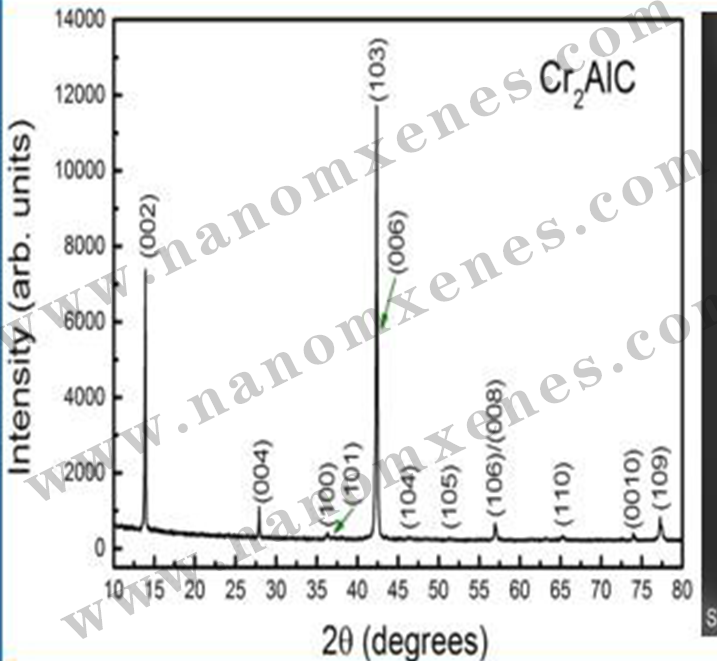product information:
Name: Cr2AlC MAX phase material (chromium aluminum carbide)
Size: 1-5um
Product performance: Excellent Mxene precursor can be processed by HF or HCl+LiF to obtain MXene
Purity:99%
Atomic mass: 143
Storage conditions: dry at room temperature
Application areas: energy storage, catalysis, analytical chemistry, mechanics, adsorption, biology, microelectronics, sensors, etc.
The size and process can be customized and can be used to prepare Mxene materials
literature:
Spintronic devices based on ferromagnetic semiconductors, such as non-volatile magnetic memory, have the advantages of low power consumption, fast operation speed, high storage density and strong data retention, and are expected to integrate storage and computing in the future Information technology and quantum computing have broad application prospects. Two-dimensional magnetic semiconductor materials are essential to improve the performance of spintronic devices. However, most two-dimensional materials, including graphene, do not have intrinsic ferromagnetism, and magnetic properties need to be introduced through methods such as doping modification. Therefore, looking for a new two-dimensional magnetic semiconductor with high Curie temperature will provide an important foundation for the research of spintronic devices. The team of Professor Sun Zhimei of Beijing University of Aeronautics and Astronautics has made progress in the research of two-dimensional magnetic semiconductor materials, which mainly includes the following two aspects. (1) Through methods such as first-principles calculations and first-principles molecular dynamics simulations, we propose a new way to obtain two-dimensional intrinsic ferromagnetic semiconductors, that is, by stripping the antiferromagnetic van der Waals semiconductor Obtain a single-layer ferromagnetic semiconductor; and predict a new type of two-dimensional intrinsic ferromagnetic semiconductor-single-layer CrOCl and CrOBr materials, the Curie temperature is much higher than the two-dimensional CrI3 and Cr2Ge2Te6 reported in the literature. The calculation results show that this series of two-dimensional materials can be obtained by a mechanical exfoliation method similar to the preparation of graphene, and has good kinetic and thermodynamic stability. This work provides new ideas for the development of new two-dimensional intrinsic ferromagnets. The predicted two-dimensional ferromagnetic CrOCl and CrOBr materials are expected to be applied to non-gyrotronic devices. (2) Prediction of semi-metallic ferromagnetic two-dimensional Cr2C crystals and metal-insulator phase transition induced by surface functionalization. Based on the hybrid functional density theory, we predicted the first semi-metal ferromagnetic material in the MXene family, with adjustable electronic properties and magnetic Cr2C, whose charge transport is completely dominated by spin-up electrons. That is, the electron flow through Cr2C will be 100% spin-polarized. The half-metal band gap of Cr2C is as high as 2.85 eV, which ensures that the 100% spin filter characteristic can be applied in a large bias voltage range. When the surface of Cr2C is saturated with F, OH, H or Cl atom groups, Cr2C will undergo a transition from metal to insulator, accompanied by a transition from ferromagnetic to antiferromagnetic. Therefore, by controlling the types of surface functionalized atomic groups, the energy gap width of the antiferromagnetic state can be well controlled.
Product introduction:
MAX phase ceramics (including titanium silicon carbide, Ti3AlC2 materials, etc.) is a new type of machinable conductive ceramic material that has attracted much attention. This type of ceramic contains more than sixty ternary carbides or nitrides. M stands for transitional front metal elements ; A represents main group elements, mainly elements of the third and fourth main groups; X represents carbon or nitrogen elements. Among them, Ti3SiC2 is the most extensively studied. Ti3SiC2 was successfully synthesized by the research group of Professor Barsoum M of Drexel University in the United States in 1996 by hot pressing, and its excellent properties were discovered. Due to the unique nano-layered crystal structure, this type of ceramic material has the properties of oxidation resistance, self-lubricating, high fracture toughness at room temperature and conductivity. Such materials can be widely used as high-temperature structural materials, electrode brush materials, chemical anti-corrosion materials and high-temperature heating elements. Products are mainly used for high temperature coatings, MXene precursors, conductive self-lubricating ceramics, lithium ion batteries, super capacitors, electrochemical catalysis.
Application Fields:
MAX has been widely used in nano-adsorption, biosensors, ion screening, catalysis, lithium ion batteries, supercapacitors, lubrication and many other fields.
Notice:
1. Large quantity discount
2. If you have any questions, please contact us
XRD





| Warm tip: the products supplied by Beijing Beike Xincai Technology Co., Ltd. are only used for scientific research, not for human body |
| Item ID | CAS | ID | Pack | Parameter | Stock | Make up | Price |
| BK2020061710-01 | 12179-41-8 | BK2020061710 | 5g | 100 | $91 | ||
| BK2020061710-02 | 12179-41-8 | BK2020061710 | 1g | 100 | $20 |
|

| Reminder: Beijing Beike New Material Technology Co., Ltd. supplies products only for scientific research, not for humans |
| All rights reserved © 2019 beijing beike new material Technology Co., Ltd 京ICP备16054715-2号 |